 W
WMensa Select is an annual award given by American Mensa since 1990 to five board games that are "original, challenging and well designed". The awards are presented at the annual Mensa Mind Games competition.
 W
WAbalone is a two-player abstract strategy board game designed by Michel Lalet and Laurent Lévi in 1987. Players are represented by opposing black and white marbles on a hexagonal board with the objective of pushing six of the opponent's marbles off the edge of the board.
 W
WApples to Apples is a party game originally published by Out of the Box Publishing, and now published by Mattel. The object of the game is to win the most rounds by playing a "red apple" card from one's hand to best "match" that round's communal "green apple" card as chosen by that round's judging player. The game is designed for four to ten players and played for 30–75 minutes.
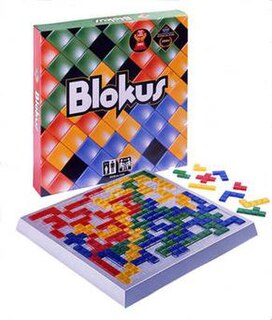 W
WBlokus is an abstract strategy board game for two to four players, where players try to score points by occupying most of the board with pieces of their colour. It was invented by Bernard Tavitian and first released in 2000 by Sekkoïa, a French company. It has won several awards, including the Mensa Select award and the 2004 Teacher's Choice Award. In 2009, the game was sold to Mattel.
 W
WBōku is an abstract strategy board game played with marbles on a perforated hexagonal board with 80 spaces. The object of the game is to arrange five marbles in a row. The game has also been sold under the name Bollox, and later Bolix and won a Mensa Select award in 1999.
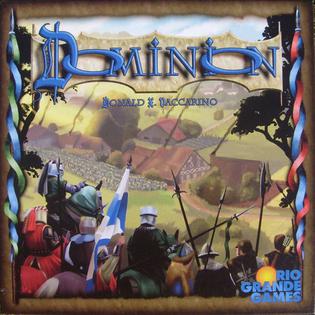 W
WDominion is a deck-building card game created by Donald X. Vaccarino and published by Rio Grande Games. Each player uses a separate deck of cards and draw their hands from their own decks, not those of others. Players use the cards in their hands to either perform actions or buy select cards from a common pool of card stacks. The player with the most victory points at the end wins. The game has a "light" medieval theme, with card names that reference pre-industrial, monarchical, and feudal social structures.
 W
WDownfall is a two-player game for players aged 7 and older, first marketed by the Milton Bradley Company in 1970.
 W
WThe Duke is a two-player abstract strategy board game played on a square-tiled gameboard, with 36 squares arranged in a 6×6 grid. The game has been compared to chess and chess variants, while retaining notable differences in unit movement and overall gameplay.
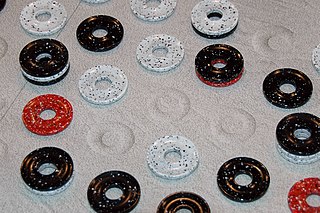 W
WDVONN is a two-player strategy board game in which the objective is to accumulate pieces in stacks. It was released in 2001 by Kris Burm as the fourth game of the GIPF Project. DVONN won the 2002 International Gamers Award and the Games magazine Game of the Year Award in 2003.
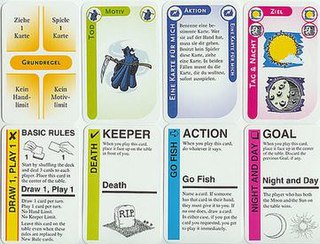 W
WFluxx is a card game, played with a specially designed deck published by Looney Labs. It is different from most other card games, in that the rules and the conditions for winning are altered throughout the game, via cards played by the players.
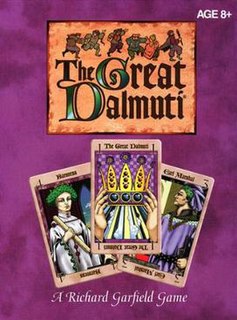 W
WThe Great Dalmuti is a shedding-type card game published by Wizards of the Coast in 1995.
 W
WIngenious is the English name for Einfach Genial, a German abstract strategy board game designed by Reiner Knizia under commission from Sophisticated Games and published in 2004 by Kosmos. Across most of Europe it is titled as the local translation of Ingenious or Simply Ingenious, the notable exception being Mensa Connections in the UK.
 W
WKhet is a chess-like abstract strategy board game using lasers that was formerly known as Deflexion. Players take turns moving Egyptian-themed pieces around the playing field, firing their low-powered laser diode after each move. Most of the pieces are mirrored on one or more sides, allowing the players to alter the path of the laser through the playing field. When a piece is struck by a laser on a non-mirrored side, it is eliminated from the game.
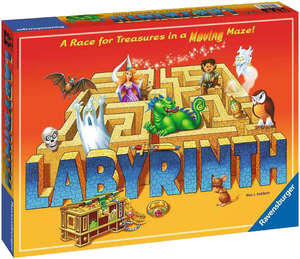 W
WLabyrinth is a board game for two to four players, published by Ravensburger in 1986.
 W
WMagic: The Gathering is a collectible and digital collectible card game created by Richard Garfield. Released in 1993 by Wizards of the Coast, Magic was the first trading card game and has approximately thirty-five million players as of December 2018, and over twenty billion Magic cards produced in the period from 2008 to 2016, during which time it grew in popularity.
 W
WNiagara is a German-style board game designed by Thomas Liesching and published in 2004 by Zoch Verlag and Rio Grande Games.
 W
WPentago is a two-player abstract strategy game invented by Tomas Flodén.
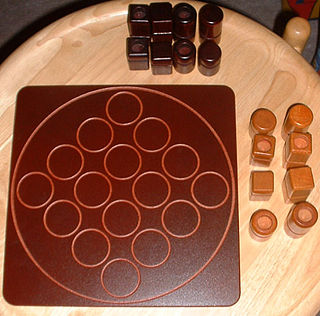 W
WQuarto is a board game for two players invented by Swiss mathematician Blaise Müller. It is published and copyrighted by Gigamic.
 W
WQuiddler is a card game and word game created by Set Enterprises. Players compete by spelling English words from cards in hands of increasing size, each card worth various points. The game combines aspects of Scrabble and gin rummy. The word "Quiddler" is a trademark.
 W
WQuoridor is a 2 or 4-player intuitive strategy game designed by Mirko Marchesi and published by Gigamic Games. Quoridor received the Mensa Mind Game award in 1997 and the Game Of The Year in the USA, France, Canada and Belgium.
 W
WQwirkle is a tile-based game for two to four players, designed by Susan McKinley Ross and published by MindWare. Qwirkle shares some characteristics with the games Rummikub and Scrabble. It is distributed in Canada by game and puzzle company Outset Media. Qwirkle is considered by MindWare to be its most awarded game of all time. In 2011, Qwirkle won the Spiel des Jahres, widely considered the most prestigious award in the board and card game industry. A sequel, Qwirkle Cubes, was released by Mindware in 2009.
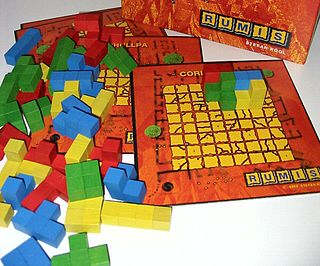 W
WRumis is a board game about optimal placement of blocks of various shapes within a confined space. Rumi means "stone" in Quechua. The theme and artwork are inspired by the Inca architecture. Rumis has also been published under the name Blokus 3-D.
 W
WRush Hour is a sliding block puzzle invented by Nob Yoshigahara in the 1970s. It was first sold in the United States in 1996. It is now being manufactured by ThinkFun.
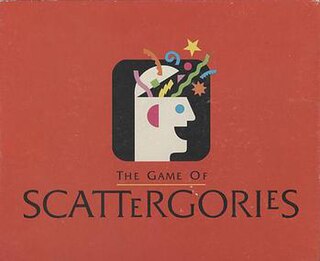 W
WScattergories is a creative-thinking category-based party game originally published by Parker Brothers in 1988. Parker Brothers was purchased by Hasbro a few years later, and they published the game internationally under their Milton Bradley brand. The objective of the 2-to-6-player game is to score points by uniquely naming objects within a set of categories, given an initial letter, within a time limit. The game is based on a traditional game known as Tutti Frutti, Jeu du Baccalauréat, Stadt Land Fluss, and many other names.
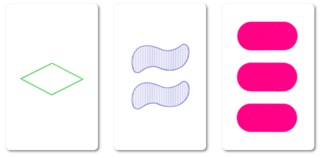 W
WSet is a real-time card game designed by Marsha Falco in 1974 and published by Set Enterprises in 1991. The deck consists of 81 unique cards that vary in four features across three possibilities for each kind of feature: number of shapes, shape, shading, and color. Each possible combination of features appears as a card precisely once in the deck.
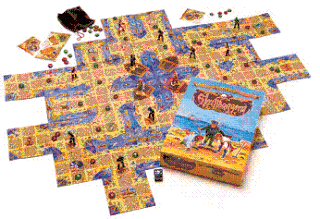 W
WSkullduggery, is a children's board game designed to teach basic logic and strategy. It was created and illustrated by Allegra Vernon, Creative Director of Outset Media. The pirate-themed game is played on a tiled board, with tokens representing the players. The game uses pirates and gemstones as enemies to create obstacles, which lends to its name. Each player works to uncover four landmarks in order to complete a treasure map and race to the treasure.
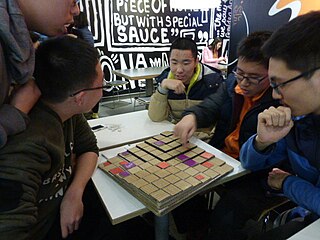 W
WTerrace is an award-winning strategy game played by two, three, or four players on a multi-leveled 8×8 board. It is most widely known for also being a prop in the American television series Star Trek: The Next Generation. There are also computer versions of the game.
 W
WYINSH is an abstract strategy board game by game designer Kris Burm. It is the fifth game to be released in the GIPF Project. At the time of its release in 2003, Burm stated that he intended it to be considered as the sixth and last game of the project, and that the game which he had not yet released, PÜNCT, would be logically the fifth game. However, an entry in his blog on 19 June 2005 suggests that he is reconsidering this.
 W
WZendo is a game of inductive logic designed by Kory Heath in which one player creates a rule for structures ("koans") to follow, and the other players try to discover it by building and studying various koans which follow or break the rule. The first student to correctly state the rule wins.
 W
WZÈRTZ is the third game in the GIPF Project of seven abstract strategy games. The game features a shrinking board and an object that promotes sacrifice combinations. Since neither player owns on-board pieces, maintaining the initiative is of fundamental importance.